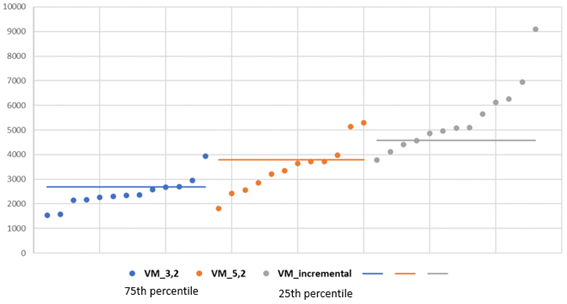Category: Huntington's Disease
Objective: to validate the use of accelerometers to quantify energy expenditure (EE) under controlled conditions for Huntington’s disease (HD) patients using Indirect Calorimetry (IC) as the gold standard and to develop tri-axial vector magnitude (VM3) cut-points to classify physical activity (PA) intensity in adults with HD
Background: HD is one of the most important genetic and neurodegenerative disorders, characterized by movement disorders [1], cognitive alterations [2] and psychiatric disorders [3][4]. Weight loss and energy deficit have been described as one of the most damaging ways for the functioning of the brain causing a detrimental effect on its evolution [5][6]. Accessible devices that provide a valid measurement of PA and EE of these subjects are needed to investigate the relationship with the different states of the disease and to be able to give guidelines and therapeutic techniques for the promotion of their health [7]. These activity monitors have been validated against IC in adults [8][9][10] but general population-derived thresholds can lead to erroneous conclusions regarding PA in HD
Method: Thirteen participants with genetic confirmation of HD, symptomatic and able to walk with minimal support, completed test walking and running at 3.2 km/h, 5.2 km/h and an incremental test on a treadmill. Fitbit Charge and Actigraph accelerometer (AA) were validated and calibrated against EE measurements by IC.
Bland–Altman plots and Interclass Correlation coefficient (ICC) were used to assess agreement between Metabolic Equivalents of Task (MET) from the AA, Fitbit and IC. Percentiles of participant-defined speed were used to develop VM3 cut-points for light, moderate and vigorous [figure 1]
Results: The ICC between IC and AA were higher than IC between Fitbit. The AA was accurate for measuring EE while the Fitbit significantly overestimated METs comparing with IC. VM3 cut-points for light, moderate, and vigorous PA intensities were ≤2679.7, >2679.7 – ≤4572.3 and >4572.3 counts min
Conclusion: Determining the accuracy of accelerometers, will facilitate the assessment of energy expenditure in free-living settings and the development of observational studies, clinical trials and therapeutic recommendations to improve lifestyles and health promotion.
VM3 cut-points for HD patients may be used to classify PA in future studies
References: [1] Quinn N, Schrag A. Huntington’s disease and other choreas. J Neurol 245(11), 709–16 (1998).
[2] Perandones C, Radrizzani M, Micheli F. Enfermedad de Huntington. In: Movimientos anormales Clínica y terapéutica, Micheli F , Médica Panamericana, Madrid (2011).
[3] Myers RH, Sax DS, Koroshetz WJ, Mastromauro C, Cupples LA, Kiely DK, et al. Factors Associated With Slow Progression in Huntington´s Disease. Arch Neurol, 48(8),800–4 (1991).
[4] Paulsen JS, Ready RE, Hamilton JM, Mega MS, Cummings JL. Neuropsychiatric aspects of Huntington ’ s disease. J Neurol Neurosurg Psychiatry, 5, 310–4 (2001).
[5] Khan W, Alusi S, Tawfik H, Hussain A. The relationship between non-motor features and weight-loss in the premanifest stage of Huntington’s disease. PLoS One, 16(7),1–24 (2021).
[6] Vercruysse P, Vieau D, Blum D, Petersén Å, Dupuis L. Hypothalamic alterations in neurodegenerative diseases and their relation to abnormal energy metabolism. Front Mol Neurosci., 11, 1–16 (2018).
[7] Duncan MJ, Roscoe CMP, Faghy M, Tallis J, Eyre ELJ. Estimating Physical Activity in Children Aged 8-11 Years Using Accelerometry: Contributions From Fundamental Movement Skills and Different Accelerometer Placements. Front Physiol, 10 (3),(2019).
[8] Freedson PS, Melanson E, Sirard J. Calibration of the Computer Science and Applications, Inc. accelerometer. Med Sci Sports Exerc [Internet]. 1998 May 1 [cited 2022 Mar 9];30(5):777–81. Available from: https://europepmc.org/article/med/9588623
[9] Bassett J, Ainsworth BE, Swartz AM, Strath SJ, O’Brien WL, King GA. Validity of four motion sensors in measuring moderate intensity physical activity. Med Sci Sports Exerc. 2000;32(9):471–80.
[10] Welk GJ, Blair SN, Wood K, Jones S, Thompson RW. A comparative evaluation of three accelerometry-based physical activity monitors. Med Sci Sports Exerc [Internet]. 2000 [cited 2022 Mar 9];32(9 Suppl). Available from: https://pubmed.ncbi.nlm.nih.gov/10993419/
To cite this abstract in AMA style:
L. Simón, E. Cubo, J. Rivadeneyra, C. Collazo, M. Soto, J. Raya, D. Castillo, S. Calvo, A. Fernández. VALIDATING ACCELEROMETRY AS A MEASURE OF ENERGY EXPENDITURE AND PHYSICAL ACTIVITY IN ADULTS WITH HUNTINGTON’S DISEASE [abstract]. Mov Disord. 2022; 37 (suppl 2). https://www.mdsabstracts.org/abstract/validating-accelerometry-as-a-measure-of-energy-expenditure-and-physical-activity-in-adults-with-huntingtons-disease/. Accessed December 31, 2025.« Back to 2022 International Congress
MDS Abstracts - https://www.mdsabstracts.org/abstract/validating-accelerometry-as-a-measure-of-energy-expenditure-and-physical-activity-in-adults-with-huntingtons-disease/

